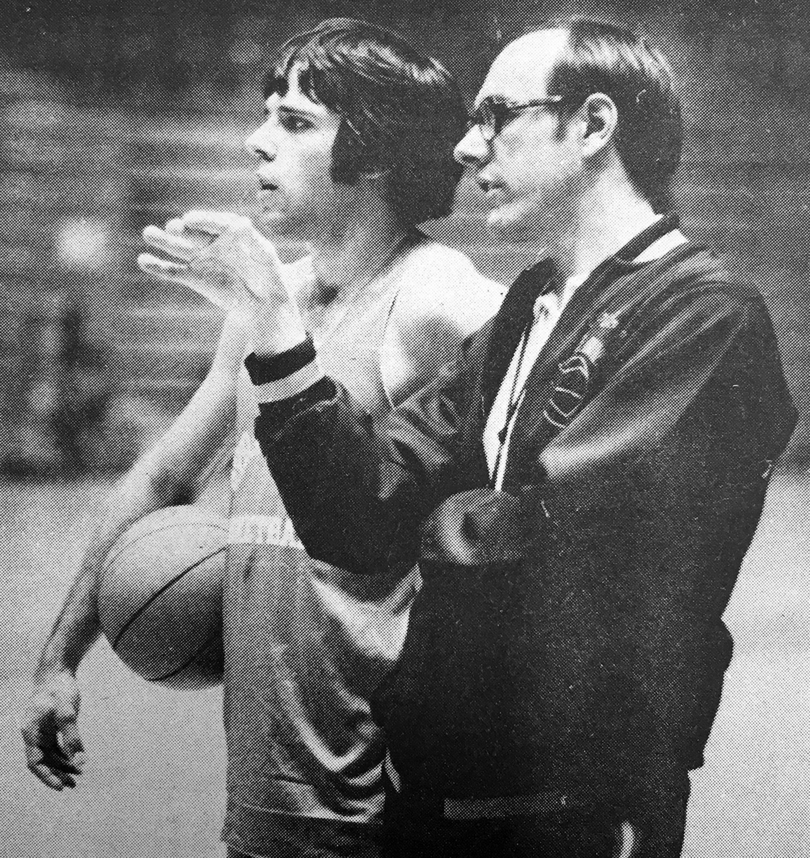Former beat writers reflect on 40 years of Jim Boeheim

Daily Orange File Photo
Jim Boeheim talks to guard Ross Kindel. Boeheim was first hired as Syracuse's men's basketball head coach in 1976. Forty years later, Boeheim is still at the helm.
As then-Daily Orange sports editor Joel Stashenko watched Jim Boeheim launch into a rant about which player the media voted Carrier Classic MVP, he could only be glad it wasn’t directed at him.
Syracuse’s Marty Byrnes had scored 18 points in the Carrier Classic championship game. Syracuse had won the four-team tournament early in the 1977-78 season, Boeheim’s second at the helm. So why, the 33-year-old Boeheim wanted to know, had this MSU freshman gotten the media’s vote for MVP?
“Jim kind of went on a tirade that someone from Syracuse, Marty Byrnes in particular, should have been the MVP,” said Budd Bailey (’77), who covered Jim Boeheim’s first season for The Daily Orange and was on a freelance assignment at the time. “And we all kind of thought it was unusual and a little prickly.
“I think it’s fair to say Jim’s shown evidence of that behavior throughout his career and that was probably the first sign of it.”
The Spartans freshman who won the MVP award was Earvin “Magic” Johnson, the future NBA Hall of Famer.
The incident showed reporters could get under Boeheim’s skin, Stashenko (’83) said. The D.O. sports editor didn’t get a vote, so luckily he had some plausible deniability.
In the 40 years since Boeheim was hired as SU’s head coach, much has changed. The program has gone from regional to national, from a good team to being nearly a 20-win lock.
“He was still maturing as a person when I knew him … I did not have a sense of him that he’d be almost an all-time winning coach,” Stashenko said.
In the first few years, Stashenko said he could catch the coach in the airport or a hotel lobby for a one-on-one interview and, save for a few instances like the 1977 Carrier Classic, the head coach was friendly with reporters.
But with the infamous “10 f*cking games” press conference 10 years ago and a few other press conference dustups with reporters, Boeheim’s surly side has shown through since that first “tirade.”
During Boeheim’s first season at SU, the Orange made the NCAA Tournament in the Mideast region. Before the first round began, the NCAA hosted a banquet in Baton Rouge, Louisiana, where Syracuse played its first game. Detroit, which was coached by legendary ESPN personality Dick Vitale, also played its first-round game there. Bailey recalls Vitale speaking at the banquet and reeling off jokes.
“Just hilarious about his experiences at Detroit about how he brought one recruit that he lost … because there was a sniper on one of the buildings on campus,” Bailey said of Vitale.
“Well, we didn’t get to keep him,” Bailey recalls Vitale saying. “So from now on it’s room, board, books and a bulletproof vest for all our recruits.”
Then, Boeheim followed. He got up, said, “Well, I’m not going to try and follow that, but thanks for inviting me … and I’m looking forward to the game,” and sat back down, Bailey remembers.
Though they saw Boeheim’s legacy begin, Stashenko and Bailey feel as if they still missed what really propelled the program into the national spotlight: the opening of the Carrier Dome and SU’s start in the Big East.
The two reporters could tell Boeheim was a good coach before those two significant changes. He inherited a program coming off a Final Four appearance in 1975 and a first-round exit in 1976 and took it to four tournaments in a row. But once the Carrier Dome was built, Syracuse was able to pack more fans into games than it had at Manley Field House. And the Big East provided high-level competition.
Both preceded Syracuse reeling in Pearl Washington, who became a legend for his conquests in New York City before he even reached Syracuse.
Bailey and Stashenko have since moved on to careers at The Buffalo News and the New York Law Journal, respectively. Neither says they could have guessed that Boeheim would ascend to the heights he has or that, 40 years later, Boeheim would stay at the same place he’s been since the head coach played at Syracuse.
“Jim Boeheim is still there year after year and time marches on and my life changes, but that’s remained a constant,” Bailey said. “… I guess when he retires down the road, it’ll be a sign that I really am getting old.”




